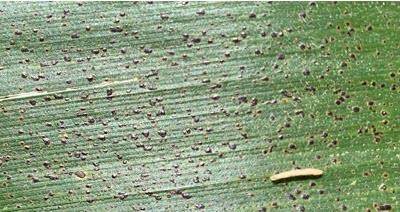Experts are working to better understand how to manage the newly arrived disease
By Jackie Clark
Staff Writer
Farms.com
Ontario ag ministry experts first identified tar spot in corn in September 2020.
This summer, producers and agronomists confirmed tar spot survived the winter and can be found in West Elgin, Essex, Chatham-Kent, Lambton, Middlesex and Norfolk Counties, according to an August 18 report from OMAFRA.
“We’re still trying to assess the impact,” Albert Tenuta, field crop pathologist for OMAFRA, told Farms.com in an August 25 interview. “Today I will add Oxford County to the list, and we’re getting reports out of Huron as well.”
As of the present, most cases are showing low incidence and severity. The fields who may see significant yield impacts are those who had tar spot early and the farmer applied no fungicide, said the August 18 report. Hot and humid conditions favour the development and persistence of tar spot.
Most affected were fields where growers observed tar spot at tassel or shortly after tassel, and humid conditions continued, Tenuta explained.
“A fungicide application for other foliar diseases is very effective,” he added.
When considering fungicide timing, “there doesn’t appear to be any benefit to fungicides before the traditional foliar leaf disease, VT or tassel, or ear rot, R1 or silking, stage, based on research results to date in the U.S. and observations from Ontario this year,” he said. “Previous fungicide trials in the U.S. and Ontario trials in progress have shown a benefit at these timings in managing tar spot.”
Researchers are now asking if there would be a benefit to later application “from milk to dough stage when the disease is present and progressing, or if a second application is warranted,” he added. “This will depend on risk factors including how much tar spot is present, is it in mid canopy (ear leaf and above) and will favourable environmental conditions continue.”

Tar spot has been reported to cause 20-60 bu/acre yield loss in the U.S. when infection occurred early and no fungicide was applied.
When 30-40 per cent infection levels are reached, lesions and stroma “result in yellowing and potential death of the leaf which can result in early shutdown or senescence of the plant,” Tenuta explained. “Besides the impact on yield, moisture, test weight, quality of the grain, premature dry-down can led to cannibalization of the plant causing stalk rot issues and standablility issues which can increase other diseases and make harvesting more difficult.”

Tar spot can spread through windborne spores, so management will require a multi-faceted approach of genetic resistance, chemical applications and cultural control, he added. “The issue with this disease is that it can build up quite quickly in a matter of three to four weeks.”
On a hopeful note, “OMAFRA and myself have been working closely with our U.S. colleagues for tar spot and other corn diseases,” Tenuta said. “So, a number of our trials that have been running in Ontario for northern corn leaf blight and other diseases are also the same fungicide products that are being looked at for tar spot as well, so we have experience with those products.”
Collaboration with the U.S. “helped our growers and industry to be prepared for this disease and other diseases as well,” he added.
Tenuta and other OMAFRA experts are working to better understand tar spot.
“There is a lot we need to learn about factors which promote tar spot development, and this includes aspects of pathogen biology, epidemiology and ecology, such as the disease cycle, inoculum survival, and spore dispersal both within the plant canopy and beyond,” he said. He’s also working to “create and distribute educational and extension resources for identification and management both in areas currently affected by tar spot and in unaffected areas that have the potential for new outbreaks.”
Albert Tenuta photos